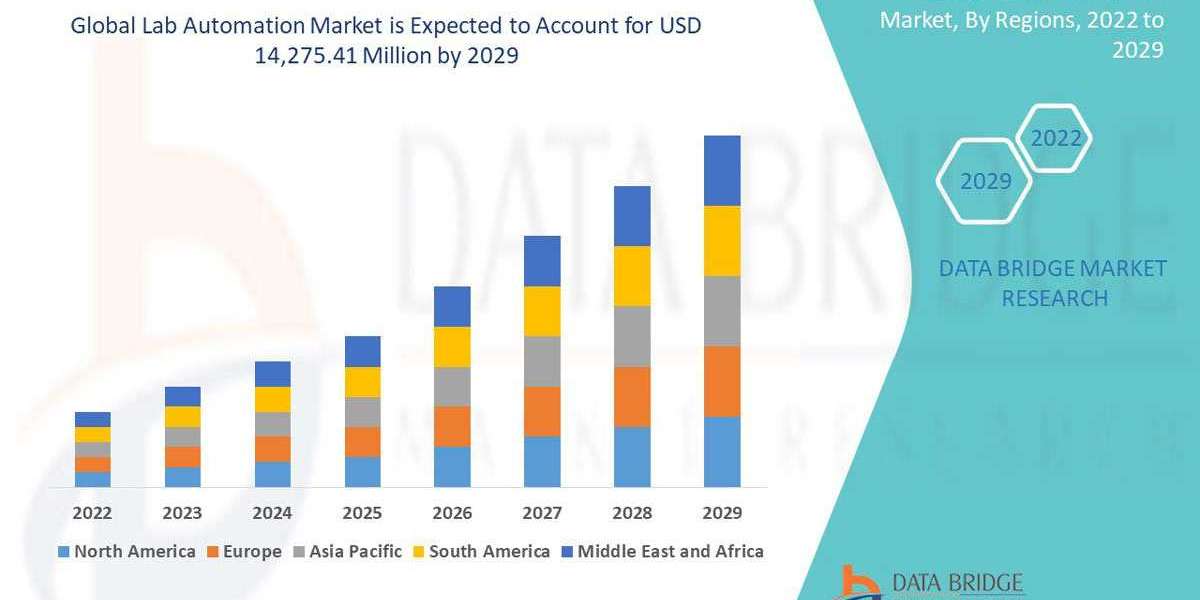What’s Fueling Executive Summary Lab Automation Market Market Size and Share Growth
CAGR Value
Data Bridge Market Research analyses that the market is growing with a CAGR of 6.6% in the forecast period of 2022 to 2029 and is expected to reach USD 14,275.41 million by 2029.
An influential Lab Automation Market Market document supports in achieving a sustainable growth in the market, by providing a well-versed, specific and most relevant product and market information. This report provides details about historic data, present market trends, future product environment, Market strategies, technological innovation, upcoming technologies, emerging trends or opportunities, and the technical progress in the related industry. Lab Automation Market Market report also takes into account strategic profiling of the major players in the market, all-inclusive analysis of their basic competencies, and hence keeps competitive landscape of the market in front of the client.
The steadfast Lab Automation Market Market research report underlines an insightful overview of product specification, technology, applications, product type and production analysis considering major factors such as revenue, cost, and gross margin. The report is a useful resource which provides present as well as upcoming technical and financial details of the industry to 2030. The market drivers and restraints have been examined using SWOT analysis. To provide clients with the best in the industry, a team of experts, skilled analysts, dynamic forecasters and knowledgeable researchers work meticulously while preparing Lab Automation Market Market business report.
Navigate the evolving landscape of the Lab Automation Market Market with our full analysis. Get your report:
https://www.databridgemarketresearch.com/reports/global-lab-automation-market
Lab Automation Market Market Outlook Forecast
Segments:
- By Equipment
The lab automation market can be segmented based on equipment into automated workstations, off-the-shelf workcells, robotic systems, automated storage and retrieval systems, and software. Automated workstations are increasingly being adopted in laboratories to streamline workflows and increase efficiency. These workstations are equipped with robotic arms and various instruments to automate tasks such as liquid handling, sample preparation, and data analysis. Robotic systems play a crucial role in automating repetitive tasks, reducing human errors, and increasing throughput in laboratories. The demand for automated storage and retrieval systems is also on the rise, as they enable efficient sample management and retrieval.
- By Software
In terms of software, the lab automation market can be segmented into laboratory information management systems (LIMS), electronic lab notebooks (ELN), laboratory automation software, and other software solutions. LIMS are widely used in laboratories to manage and track sample data, automate workflows, and ensure regulatory compliance. ELNs are digital platforms that allow researchers to record and manage experimental data electronically. Laboratory automation software provides tools for instrument integration, data analysis, and workflow optimization, contributing to increased efficiency and productivity in laboratories.
- By End-User
Based on end-user, the lab automation market can be segmented into pharmaceutical and biotechnology companies, academic and research institutes, contract research organizations (CROs), hospitals and diagnostic labs, and other end-users. Pharmaceutical and biotechnology companies are the major end-users of lab automation solutions, as they seek to streamline drug discovery and development processes. Academic and research institutes utilize lab automation technologies to enhance research capabilities and accelerate scientific discoveries. CROs rely on lab automation to meet the growing demand for outsourced research services.
Market Players:
- Thermo Fisher Scientific, Inc.
Thermo Fisher Scientific is a leading player in the global lab automation market, offering a wide range of automated solutions for various laboratory applications. The company's portfolio includes automated workstations, robotic systems, and software platforms designed to improve laboratory efficiency and productivity.
- Agilent Technologies, Inc.
Agilent Technologies is another key player in the lab automation market, known for its innovative solutions in automated sample preparation, data analysis, and laboratory informatics. The company's products cater to the needs of pharmaceutical, biotechnology, and research laboratories worldwide.
- Bio-Rad Laboratories, Inc.
Bio-Rad Laboratories is a prominent player in the lab automation market, offering solutions for automated PCR, liquid handling, and data management. The company's advanced technologies help laboratories streamline their workflows and achieve accurate results.
The global lab automation market is poised for significant growth, driven by the increasing adoption of automated solutions in laboratories worldwide. Technological advancements, rising demand for high-throughput screening, and the need for improved data accuracy and reproducibility are key factors contributing to market expansion.
The global lab automation market is experiencing a paradigm shift in the way laboratories operate, driven by advancements in technology and the increasing need for efficiency and accuracy in scientific research and analysis. One emerging trend in the market is the integration of artificial intelligence (AI) and machine learning algorithms into lab automation systems. These technologies are being leveraged to enhance data analysis capabilities, identify patterns and trends in large datasets, and optimize experimental processes. By incorporating AI-driven solutions, laboratories can improve decision-making, drive innovation, and accelerate research outcomes.
Another significant development in the lab automation market is the emphasis on modular and scalable automation solutions. Laboratories are increasingly opting for flexible automation platforms that can be easily customized and scaled to meet evolving research needs. Modular automation systems allow for seamless integration of new instruments and technologies, enabling labs to adapt to changing requirements without the need for extensive reconfiguration. This trend towards modularization is enhancing operational efficiency, reducing downtime, and maximizing the return on investment for lab automation solutions.
Furthermore, the integration of cloud-based technologies in lab automation is revolutionizing data management and accessibility in laboratories. Cloud computing platforms offer secure storage, sharing, and analysis of experimental data in real-time, facilitating collaboration among researchers across different locations. By leveraging the cloud, laboratories can centralize data management, ensure data integrity, and enhance research reproducibility. Cloud-based lab automation solutions also enable remote monitoring and control of laboratory processes, empowering researchers to access and analyze data anytime, anywhere.
Moreover, the increasing focus on sustainability and environmental conservation is influencing the design and implementation of lab automation systems. Manufacturers are incorporating energy-efficient components, recyclable materials, and waste reduction strategies in their automation solutions to minimize environmental impact. Sustainable lab automation practices not only contribute to cost savings and regulatory compliance but also align with the growing corporate responsibility initiatives of laboratories worldwide.
In conclusion, the global lab automation market is witnessing transformative changes driven by technological innovation, modularization, cloud integration, and sustainability initiatives. Laboratories that embrace these trends and adopt advanced automation solutions are poised to enhance their operational efficiency, accelerate scientific discoveries, and stay ahead in a competitive research landscape. As the demand for high-throughput screening, data accuracy, and workflow optimization continues to grow, the lab automation market is expected to experience sustained growth and diversification in the coming years.The global lab automation market is witnessing a significant transformation driven by various key trends and developments. The integration of artificial intelligence (AI) and machine learning algorithms is revolutionizing data analysis capabilities, enabling laboratories to identify patterns and trends in large datasets efficiently. By leveraging AI-driven solutions, researchers can enhance decision-making processes, drive innovation, and accelerate research outcomes, ultimately improving efficiency and productivity in laboratories.
Furthermore, the shift towards modular and scalable automation solutions is reshaping the way laboratories operate. Flexible automation platforms allow for easy customization and scalability to meet evolving research needs, empowering labs to adapt quickly to changing requirements without extensive reconfiguration. This trend towards modularization enhances operational efficiency, reduces downtime, and maximizes the return on investment for lab automation solutions, providing laboratories with the agility needed to stay competitive in the rapidly evolving research landscape.
Moreover, the integration of cloud-based technologies in lab automation systems is facilitating enhanced data management and accessibility. Cloud computing platforms enable secure storage, sharing, and real-time analysis of experimental data, fostering collaboration among researchers across different locations. By centralizing data management and ensuring data integrity, cloud-based lab automation solutions improve research reproducibility and empower researchers with remote monitoring and control capabilities, enhancing operational efficiency and overall productivity in laboratories.
Additionally, there is a growing focus on sustainability and environmental conservation in the design and implementation of lab automation systems. Manufacturers are increasingly incorporating energy-efficient components, recyclable materials, and waste reduction strategies to minimize environmental impact. Embracing sustainable practices not only results in cost savings and regulatory compliance but also aligns with the corporate responsibility initiatives of laboratories worldwide, contributing to a more environmentally friendly and responsible approach to lab automation.
In conclusion, the global lab automation market is experiencing a paradigm shift driven by technological advancements, modularization, cloud integration, and sustainability initiatives. Laboratories that embrace these trends and adopt advanced automation solutions are poised to enhance operational efficiency, accelerate scientific discoveries, and maintain a competitive edge in the dynamic research landscape. As the demand for high-throughput screening, data accuracy, and workflow optimization continues to grow, the lab automation market is expected to see sustained growth and diversification in the coming years, shaping the future of scientific research and analysis.
Inspect the market share figures by company
https://www.databridgemarketresearch.com/reports/global-lab-automation-market/companies
Lab Automation Market Market Research Questions: Country, Growth, and Competitor Insights
- What is the full scope of the Lab Automation Market Market valuation?
- What is the average growth rate expected post-2025?
- What segmentation variables are most impactful?
- Which firms lead in sustainability within the Lab Automation Market Market?
- What product categories are showing exponential growth?
- Which countries are expanding their consumer base?
- What is the most rapidly developing regional economy?
- Which nations have the highest investment inflow?
- What region is setting pricing benchmarks?
- What are the innovation challenges facing this Lab Automation Market Market industry?
Browse More Reports:
Global Reverse Osmosis (RO) Membrane Filtration Market
Middle East and Africa Self-Organizing Network (SON) Market
Global Laparoscopic and Open Hernia Mesh Repair Surgery Market
Global Enterprise High-Productivity Application Platform as a Service Market
Global Proton Therapy Market
Global Cleanroom Films and Bags Market
North America Condensing Unit Market
Global EV Test Equipment Market
Global Resistance Bands Market
Global Colonoscopes Market
Global Ultra-efficient Solar Power Market
Global Muconic Acid Market
Global Cancer Care Market
Global Coccidioidomycosis Drugs Market
Global Cereal Bar Market
Global Chromatography Software Market
North America Free Standing Electrical Height-Adjustable Tables Market
Global Smart Grid Technology Market
Global Lincomycin Market
Middle East and Africa Women’s Health Diagnostics Market
Global Yogurt Powder Market
Asia-Pacific Hummus Market
Global Anti-Fog Lidding Films Market
Middle East and Africa Interstitial Cystitis Market
Asia-Pacific Proton Therapy Market
About Data Bridge Market Research:
An absolute way to forecast what the future holds is to comprehend the trend today!
Data Bridge Market Research set forth itself as an unconventional and neoteric market research and consulting firm with an unparalleled level of resilience and integrated approaches. We are determined to unearth the best market opportunities and foster efficient information for your business to thrive in the market. Data Bridge endeavors to provide appropriate solutions to the complex business challenges and initiates an effortless decision-making process. Data Bridge is an aftermath of sheer wisdom and experience which was formulated and framed in the year 2015 in Pune.
Contact Us:
Data Bridge Market Research
US: +1 614 591 3140
UK: +44 845 154 9652
APAC : +653 1251 975
Email:- corporatesales@databridgemarketresearch.com








